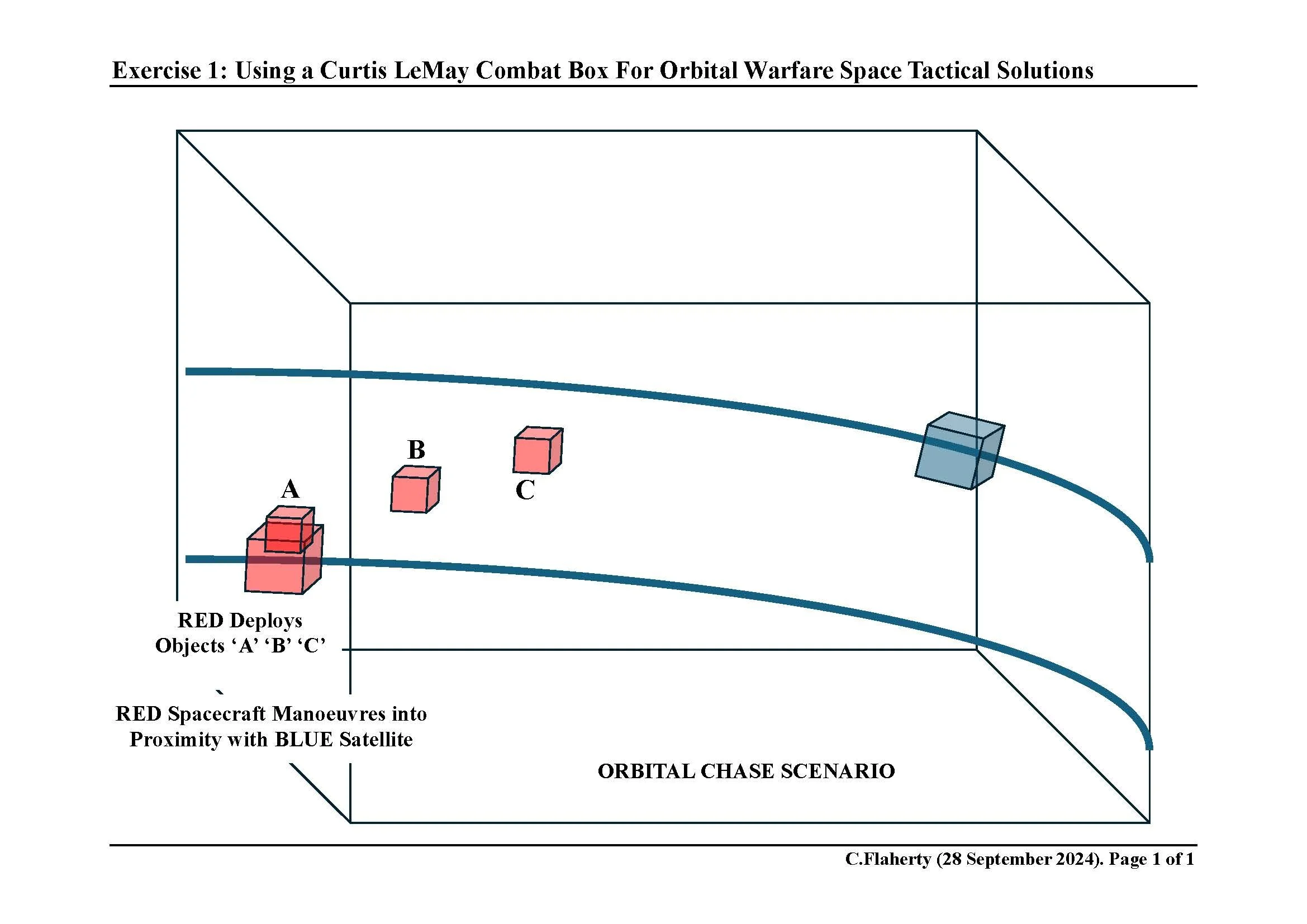ORBITAL WARFARE HISTORY is a research website dedicated to documenting the military history of Orbital Warfare that emerged at the end of WW2, till currently, and the emerging concept of Orbital Manoeuvre Warfare.
… It can be predicted looking at current technology and concept development trends we are about to see a Space Power transformation, where Space Situational Awareness and in-Space Antisatellite technology onboard manoeuvrable satellites replace the historical threat posed by Direct Ascent Antisatellite Weapons (that have become redundant).
Orbital Warfare History is intended for Space defence and security professionals, history enthusiasts, film and media industry, and wargamers. This website looks at the technology, and military theory that developed at the end of WW2 to put a satellite into Earth Orbit.
Chris Flaherty
EARTH PLANETARY DEFENCE AND RELATED ORBITAL WARFARE CONCEPTS
DEFINITION OF ORBITAL WARFARE
Spacecraft are constantly in motion so manoeuvre is generally taken to mean a change in a spacecraft’s motion rather than the underlying motion itself, thus: ‘Space Systems Manoeuvre: is to change orbits or locations’ [Newberry, R.D. 1997 Space Doctrine for the 21st Century. Air Command and Staff College (March)].
United States Space Force officers recently defining orbital warfare, stated in our teaching missions, “we … [are] … getting down even to the basic levels of do we use the right terms to describe orbital warfare?” [Getrost, J. Bejcek, M.D. Galbreath, C. (Penney, H. Host) 2024 AA–Episode 190. Orbital Warfare Transcript. Mitchell Aerospace Power (1 July)]
The July 2023 definition for, “Orbital warfare uses orbital manoeuvre and offensive and defensive fires to preserve freedom of access to the domain and allows the United States and its allies and partners to deny the adversary the same advantage.” [Space Training and Readiness Command. 2023 Space Doctrine Publication 2-0, Intelligence (19 July); Air Command and Staff College. 2023 AU-18 Space Primer. Air University Press]
United States Space Force officers recently defining orbital warfare, stated: “[it] … is a lot more than just … the orbital mechanics of … two vehicles manoeuvring around each other.” [Getrost, 2024] An important component to Space Power achievement is, “Space Domain Awareness” [Getrost, 2024]. Which is understanding, “how … threat systems could impact our entire constellation and the effects that they provide to our warfighters on the ground and in the air and at sea” [Getrost, 2024]. An orbital manoeuvre problem may be that an opponent vehicle nears a high value asset in orbit, as it moves closer, the defensive ploy may be to move away to ensure there is distance, to allow some reaction time in order to mitigate any potential attack [Getrost, 2024]. This also requires the defensive force, “[to] … maintain … awareness of what it is doing” [Getrost, 2024].
See Space Situational Awareness (Space Domain Awareness)
Another definition of Orbital Warfare can be, “Warfare conducted whereby the attack vector originates in the Space Domain.” [Lynch, A.D. 2020 Analogical Reasoning in Orbital Warfare. Air University, Maxwell Air Force Base, Alabama. Graduate Thesis (June)] In Chinese military literature, the People’s Liberation Army’s Space Blockade stands as another potential definition of Orbital Warfare:
“In Space Blockade Operations, the main goal lies in blocking the enemy space forces from … conducting Orbital Manoeuvre, and not in seeking to thoroughly wipe out the enemy. As long as the enemy cannot timely and effectively carry out space launch and Orbital Manoeuvre, the blockade operations will directly achieve their goal.” [Burke, K. 2023 PLA Counterspace Command and Control. China Aerospace Studies Institute (December)]
The People’s Liberation Army’s Space Blockade concept possibly envisages large spacecraft moved in the way of another country’s satellite communications path, which would complicate its communication mission and could also challenge its ability to safely manoeuvre [Burke, 2023].
On this website – Orbital Warfare is defined: ‘Space to Space manoeuvre and combat between craft in Orbital Space that are physically separate from the Human operators on Earth.’ This definition is based on a major assumption about the conduct of Orbital Warfare, it will continue with, “spatial separation of Human combatants from their weaponry.” [Ramey, R.A. 2000 Armed Conflict on the Final Frontier: the Law of War in Space. The Air Force Law Review. Volume 48]
Orbital Warfare Constraints: A key constraint on Orbital Warfare, is ensuring space superiority, “while also maintaining the safety, security, stability, and long-term sustainability of the Space Domain.” [Office of the Chief of Space Operations. 2024 White Paper on Competitive Endurance: A Proposed Theory of Success for the U.S. Space Force. Strategic Initiatives Group (11 January)] One of the key risks of a combat in Space is doing so, “without generating hazardous debris.” [Office of the Chief of Space Operations, 2024]
ORBITAL WARFARE ATTACK (OFFENSIVE), DEFENCE (DEFENSIVE), OR RESISTANCE?
Use of the phrase – ‘Space Control’ can become problematic in a unique and exotic environment such as Space – which given our current level of technology is protecting an orbital position or slot, from objects, Cyber or Electronic Warfare attacks. The ‘control notion’ is an adaptation of the original dual concept of sea control versus denial strategies; however, in the context of a circumplanetary conflict there are two strategic levels:
(1) The View from the Ground which is attempting to deter an opponent from aggressive/destructive acts in Space within an international framework. However, as we are seeing in the current Russo-Ukrainian war, which has a Space War dimension – the international system of norms and behaviour has been disregarded by one of the opponents.
(2) The View from Space is defined by the current limits of satellite-spacecraft technology. That is progressively changing as the next generation of craft become more manoeuvrable. In which case, the notion of Space Control, is superseded by Space Manoeuvrability and Avoidance Strategies between orbits, in relation to the planet’s rotation.
Most texts reduce roles and function to an ‘Attack’ (offensive), or ‘Defence’ (defensive) duality, whereas the original conception in the interwar years was, ability to operate offensively, defensively, and have resistance in a tactical environment. I would suggest the later – Resistance in relation to maintaining the viability of a Space asset in terms of it being rugged enough to withstand an attack: which is where most satellite-spacecraft technology is currently evolving.
Currently, modern formulation for the resistance component, is found in the concept of ‘resilience’, that assert, “space mission assurance may be enhanced or achieved through one or more of the following features or actions: defensive operations; reconstitution; resilience; disaggregation; distribution; diversification; active or passive protection; proliferation; and deception.” [Office of the Assistant Secretary of Defense for Homeland Defense & Global Security. 2015 Space Domain Mission Assurance: A Resilience Taxonomy. White Paper (September); Joint Publication 3-14: Space Operations]
WEBSITE CONTENTS ‘the Orbital Warfare building blocks’:
About - What is Orbital Warfare and How Did it Start
Earth’s Satellite Layer, Complexity Inversion and Rise of Orbital Warfare
U.S. and Soviet Circumplanetary Warfighting Concepts
Orbital Area Weapons History and Warfare Theory
Fighting, Guardian and Inspection Satellites in Orbital Warfare
Fighting, Guardian and Inspection Satellites in Orbital Warfare (Part 2)
ORBITAL WARFARE WARGAMING
Current Orbital Warfare Wargaming Developments
Manoeuvre Tactics Problem in Orbital Space Environment
Orbital Manoeuvre Attack: Key Concepts
ORBITAL WARFARE WARGAMING (PART2)
Orbital Manoeuvre Defence, Avoidance, Chase: Key Concepts
ORBITAL WARFARE MANOEUVRE TACTICS
Stalking-Satellite Tactics (Orbital Manoeuvre Stalking Tactics)
ORBITAL WARFARE MANOEUVRE TACTICS (PART 2)
Satellite Rendezvous Tactics
ORBITAL WARFARE MANOEUVRE GROUND COMPONENT
Space-Link-Ground/User Segments and Space Domain/Situational Awareness Component Model
Ground Control Component
Space Situational Awareness (Space Domain Awareness)
DYNAMIC ORBITAL MANOEUVRE REVOLUTION
ORBITAL TEST RANGES DEVELOPMENT
CIRCUMLUNAR ORBITAL WARFARE MANOEUVRE
Cislunar and Lunar Surface Exotic Battlefield Environment
Translating Orbital Manoeuvre Warfare Concepts to Cislunar Space
Cislunar Space Patrolling (Cislunar Space Situational Awareness/Cislunar Space Domain Awareness)
ORBITAL WARFARE WARGAMING RULES
Orbital Warfare Wargaming Rules provides an introductory set of wargaming rules for Circumplanetary Battle between two opponent forces of satellites, which employ Orbital Manoeuvre Attack, Defend, Avoidance and Chase Tactics. Using models on a playing table the game concept is intended as a set of playable rules aimed at introducing a basic level understanding of Orbital Manoeuvre between opposing satellites in Earth Orbit.
Orbital Manoeuvre Rules Sheet…. Coming Soon!
Orbital Combat Rules Sheet…. Coming Soon!
….in the Past there was Lunar Surface Warfare 1960!
Wargaming Rules and Scenarios
C.Flaherty
Soldiershop 2021
This short book on Lunar Surface Warfare in the 1960s, presents a set of wargaming rules for combat between Soviet Cosmonauts and United States Army and Airforce Soldier-Astronauts. It is based on early popular science, and military studies conducted in the 1950s, and 1960s that looked at how the US Army, or Airforce would establish a military presence on the Earth's Moon, and would defend that against the Soviets.
RESEARCH & DISCUSSION PAPERS ON SPACE WARFARE THEORY
► NASA. 1961 Dyna-Soar on Titan Booster. The Boeing X-20 Dyna-Soar (Dynamic Soarer) was a United States Air Force program to develop a spaceplane that after separation from an upper stage booster could be used for a variety of military missions in Orbital Space including rendezvous with a satellite. An upper stage attached to the aft end of the craft would allow orbital manoeuvres and a launch abort capability before being jettisoned for descent into the atmosphere to land.




